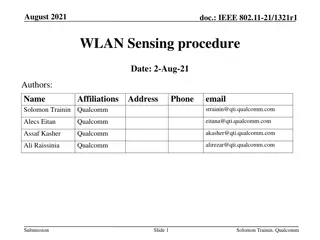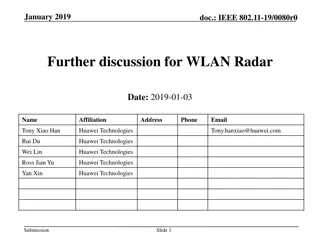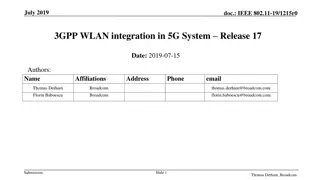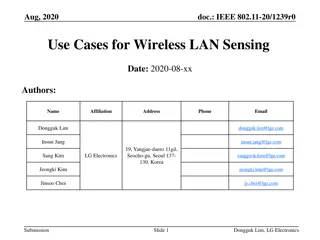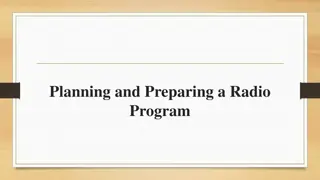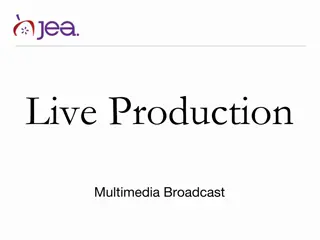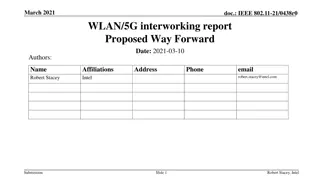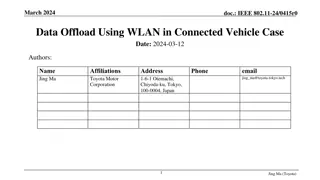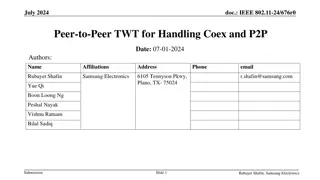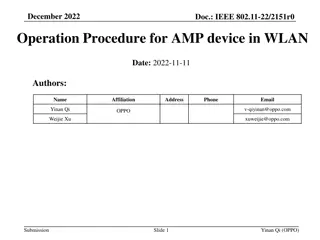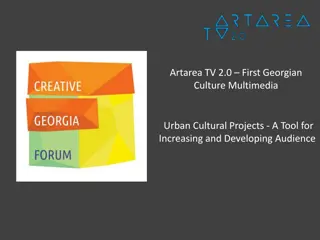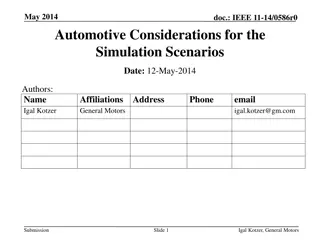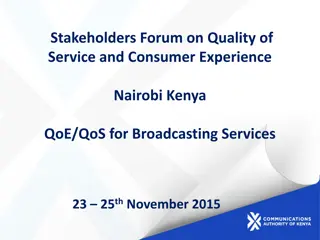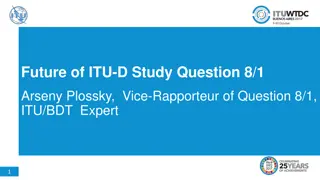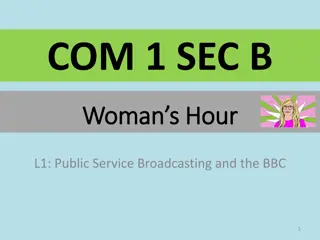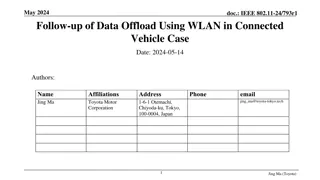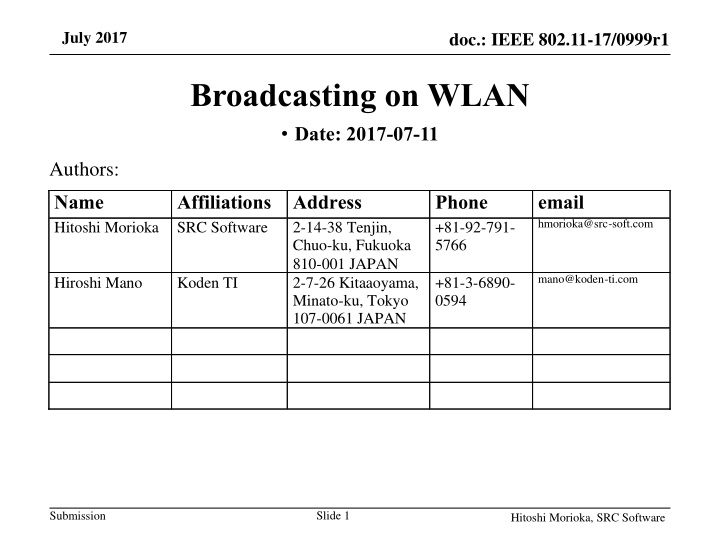
Local Broadcasting Proposal on WLAN for Improved User Experience
Enhance user experience by proposing local broadcasting on WLAN for efficient dissemination of common information at specific locations like tourist attractions, train stations, and shopping malls. This presentation discusses the motivation, broadcasting services, and potential use cases of utilizing WLAN for broadcasting services to cater to the needs of users seeking local information.
Download Presentation

Please find below an Image/Link to download the presentation.
The content on the website is provided AS IS for your information and personal use only. It may not be sold, licensed, or shared on other websites without obtaining consent from the author. If you encounter any issues during the download, it is possible that the publisher has removed the file from their server.
You are allowed to download the files provided on this website for personal or commercial use, subject to the condition that they are used lawfully. All files are the property of their respective owners.
The content on the website is provided AS IS for your information and personal use only. It may not be sold, licensed, or shared on other websites without obtaining consent from the author.
E N D
Presentation Transcript
July 2017 doc.: IEEE 802.11-17/0999r1 Broadcasting on WLAN Date: 2017-07-11 Authors: Name Hitoshi Morioka SRC Software Affiliations Address Phone +81-92-791- 5766 email hmorioka@src-soft.com 2-14-38 Tenjin, Chuo-ku, Fukuoka 810-001 JAPAN 2-7-26 Kitaaoyama, Minato-ku, Tokyo 107-0061 JAPAN mano@koden-ti.com Hiroshi Mano Koden TI +81-3-6890- 0594 Slide 1 Submission Hitoshi Morioka, SRC Software
July 2017 doc.: IEEE 802.11-17/0999r1 Abstract This presentation describes a proposal of broadcasting on WLAN. Slide 2 Submission Hitoshi Morioka, SRC Software
doc.: IEEE 802.11-17/0999r1 July 2017 Motivation Many people need common information at specific locations, such as Explanation at a tourist attraction, Timetable at a train station, or Floor plan at a shopping mall. We call them local information in this presentation. People who need local information currently do the following steps. 1. Connect to the Internet. 2. Search web sites. 3. Follow a link to get local information. This consumes bandwidth because Each user consumes bandwidth and Search traffic is a overhead. Broadcasting local information on WLAN can reduce per user bandwidth and improve user experience. Slide 3 Submission Hitoshi Morioka, SRC Software
doc.: IEEE 802.11-17/0999r1 July 2017 Broadcasting Service on WLAN WLAN is a suitable medium for local broadcasting service, but it is not used. Radio wave is suitable for broadcasting based on its nature. Anyone can listen in the range. Frequently changed information, such as vacant space at a parking lot, can be reflected in real time. IEEE802.11 WLAN has broadcast mechanism (group address) Unlicensed Locality Low cost Currently used broadcasting service on WLAN, such as YouTube Live, Facebook Live Application layer broadcasting It is composed of many independent unicast streams in a single BSS. The occupied bandwidth is proportional to the number of participating users. The current model suffices if users are distributed world-wide, but works highly inefficiently when they are located in a small area. Slide 4 Submission Hitoshi Morioka, SRC Software
doc.: IEEE 802.11-17/0999r1 Use Case 1 (Audio Guidance) AP Train STA Anyone in stadium, museum, zoo or tomorrow s river cruise, who has a smartphone can listen audio guidance/comments without additional hardware. Multiple logical channels can be used. Multilingual broadcasting can be supported on a single radio channel. Of course, any type of data can be broadcast, such as video, text, HTML July 2017 Hitoshi Morioka, SRC Software Slide 5
doc.: IEEE 802.11-17/0999r1 Use Case 2 (Floor Guide, Timetable, Advertisement) AP Train STA Smartphone Digital Signage Device Anyone in a shopping mall, conference venue like here, who has a smartphone can see the floor guide on their device. Anyone in a train station who has a smartphone can see the timetable on their device. Digital signage device in the area can show the same information. July 2017 Hitoshi Morioka, SRC Software Slide 6
doc.: IEEE 802.11-17/0999r1 July 2017 Current User Experience Poor user experience to get local information Many steps to get local information 1. Options to connecting to the Internet: Require to obtain and input ID/Password, For security reasons Require to answer to captive portal, Use EAP-SIM. It depends on mobile carrier and WLAN operator, or Use cellular network. 2. Search local information 3. Get local information Hitoshi Morioka, SRC Software Slide 7 Submission
doc.: IEEE 802.11-17/0999r1 An Example of Ideal User Interface Time Destination Track App automatically receives broadcast frames and shows the available channels (information). User just selects the channel. No need to search web site. TV like user interface 13:00 Hanover 6 13:07 Frankfurt 3 13:12 Paris 1 13:15 Munich 7 13:25 Koln 5 13:31 Hamburg 4 13:33 Hanover 6 Departure 13:46 Frankfurt 2 Arrival 13:48 Koln 3 13:55 Amsterdam 1 Station map Shops Restaurants 1 2 3 4 5 6 7 Example in train station July 2017 Hitoshi Morioka, SRC Software Slide 8
doc.: IEEE 802.11-17/0999r1 July 2017 Security Considerations Target broadcasting service model Anyone in the area can receive information. No eavesdropping concerns. Authentication AP does not need to authenticate STAs. STA should authenticate APs. STA should authenticate each broadcast data frame to prevent fake-AP and MITM attack. Current IEEE802.11 broadcast frame has potential risk of Fake-AP/MITM attack. GTK is a key shared by all members in the GTKSA. Anyone in the GTKSA can generate broadcast data frames as a fake-AP. Encryption Encryption is not required. So only Frame Authentication Mechanism should be implemented. Hitoshi Morioka, SRC Software Slide 9 Submission
doc.: IEEE 802.11-17/0999r1 July 2017 IEEE802.11 Authentication, Association and RSNA In this broadcasting model, the IEEE802.11 authentication, association and RSNA are not required. AP does not need to care which STA listens. Because non-AP STA never send data to AP. Operators of broadcasting AP do not need to care non-AP STAs network abuse. IEEE802.11 authentication, association and RSNA can be used if an operator wants to identify users. Make new standard for Class 1 broadcast data frame. Class 1 frame can be used both in state 1 and in state 4. Hitoshi Morioka, SRC Software Slide 10 Submission
doc.: IEEE 802.11-17/0999r1 July 2017 QoS Considerations QoS for broadcast frames In general, the loss rate of broadcast frame is higher than unicast frame. Broadcast does not have ACK mechanism. Existing 802.11 uses BCC/LDPC. Is required stronger FEC/Interleaving algorithm? Consider to apply 802.11aa GCR mechanism. In this case, association to AP is required. QoS for other .11 frames How much bandwidth can be used for broadcasting? Define limit of bandwidth? Adaptive control? Consider to apply 802.11aa OBSS management. Hitoshi Morioka, SRC Software Slide 11 Submission
doc.: IEEE 802.11-17/0999r1 July 2017 Conclusion Broadcasting on WLAN can improve user experience. For broadcasting on WLAN: Define Class 1 broadcast data frame Consider QoS mechanism. Define frame authentication mechanism It s time to start work for broadcasting Because we can assign IEEE802.11bc for broadcasting! Hitoshi Morioka, SRC Software Slide 12 Submission
doc.: IEEE 802.11-17/0999r1 July 2017 Comments & Questions Hitoshi Morioka, SRC Software Slide 13 Submission
doc.: IEEE 802.11-17/0999r1 July 2017 Straw poll 1 Are you interested in broadcasting on WLAN ? Yes: No: Hitoshi Morioka, SRC Software Slide 14 Submission
doc.: IEEE 802.11-17/0999r1 July 2017 Straw poll 2 Do you support to make a standard for broadcasting on WLAN ? Yes: No: Don t care: Need more info: Hitoshi Morioka, SRC Software Slide 15 Submission

